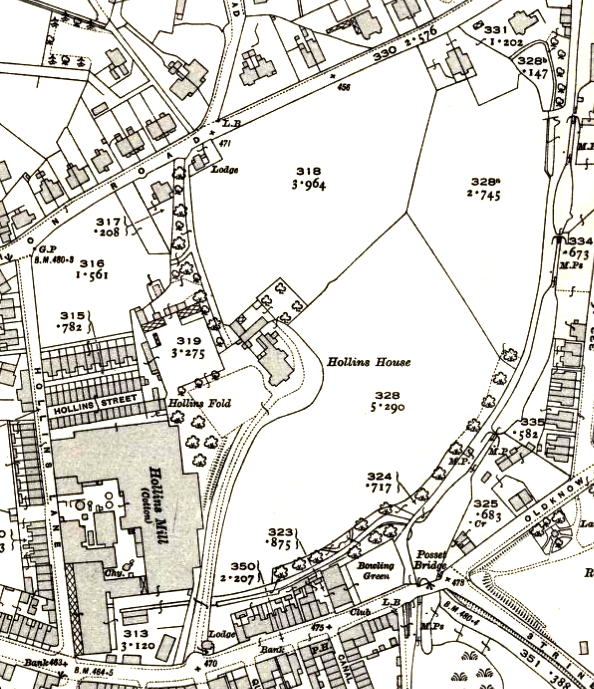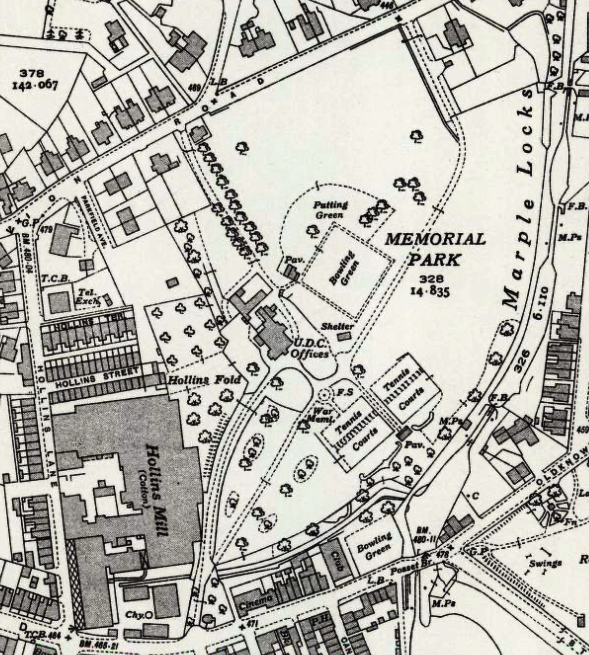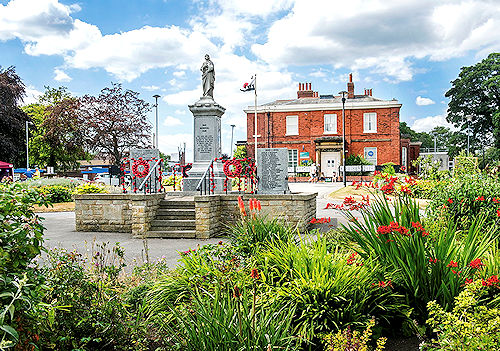
It was 1919. The War to End All Wars was over and demobilisation was beginning. Millions of men were returning but not all men. Almost 900,000 British soldiers were killed in Belgium, France and the other battlefields and virtually every community in the country had lost men and some women. There were a few communities where all their sons returned, but Marple was not one of them. One hundred and forty one soldiers, sailors and airmen would not be coming home.
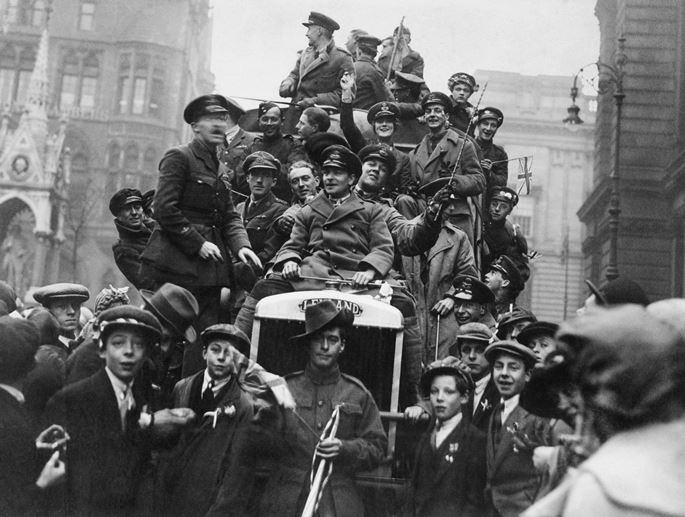
Armistice Day 1918 [IWM] Source: https://www.iwm.org.uk/history/armistice-day-1918-in-pictures
On February 17th, a public meeting was held in Trinity Hall, part of the Trinity Methodist Church on Market Street. Councillor Pickles was in the chair and the purpose was to decide on a fitting memorial for the men of Marple who would not be returning. There would, of course, be a memorial to the fallen - that was never in question. The purpose of this meeting was to decide how to celebrate the living. A wide variety of suggestions were made and debated and eventually six ideas were put forward for further investigation:
- Scholarships
- Cottage hospital
- Public park
- Swimming baths
- Endowment of lectures
- Public hall
A small committee was formed to look at these ideas in more detail and to report back. They soon reduced the six ideas to three - scholarships, a cottage hospital and endowing lectures. Scholarships would cost in the region of £5-6,000 and a cottage hospital rather more, say £8-9,000 plus annual expenses of about £500. After discussion it was decided that a hospital would be too big a commitment. Financing scholarships would be a more realistic target but since the first meeting the mill owners had come up with another suggestion. Four men from the wider Carver family had been killed. It was suggested that the Hollins Estate would give eight acres to the the town for a public park, to be called Carver-Barlow Park.
All four of the men were grandsons of Thomas Carver whose family had bought the mill in the 1850s in partnership with the Hodgkinson family. Thomas’s eldest son, Oswald and his wife Kate, had lost two sons. Oswald, their eldest son was killed at Gallipoli in June 1915 and just over a year later another son, Basil, was killed on the Western Front at the age of nineteen. Thomas’s eldest daughter, Mary, had married Frank Barlow and they had four daughters and a son. That son, Harold Barlow, was shot down by the Red Baron in June 1917. Thomas’s second son, Ernest, had married Alice Bagshawe of an old Derbyshire family. He had adopted her family name and they had four children but their son Geoffrey, had been the first of the Carver family to be killed, at Ypres in May 1915. Thomas, the grandfather, had died in 1911 so he had none of the heartbreak suffered by his children.
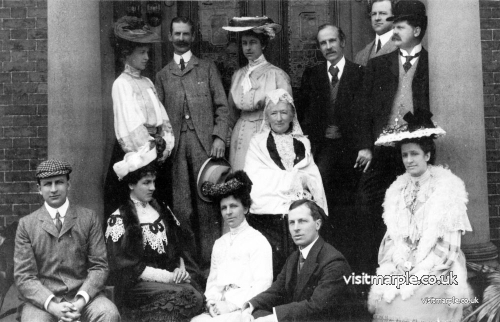
Carver Family 1904
The celebrations of Thomas and Hannah Carver's Golden Wedding anniversary in 1904
Back row (l-r): Kate, Oswald, Bessie, Thomas, Ernest, Frank Barlow.
Centre: Hannah. Front: Roberton, Grace, Jessie, Tom, Mary Barlow.
All surnames are Carver unless noted otherwise.
Seven weeks after the initial meeting, a second public meeting was held in the Trinity Hall. It was crowded and led to a vigorous debate. Both of the committee-sponsored proposals were tabled but that did not deter alternate suggestions from the floor - an addition to the Cripples’ Home, training for the blind, a memorial hall. After a full discussion the chairman took a vote. By a show of hands a large majority were in favour of one particular scheme. It was to be a memorial park.
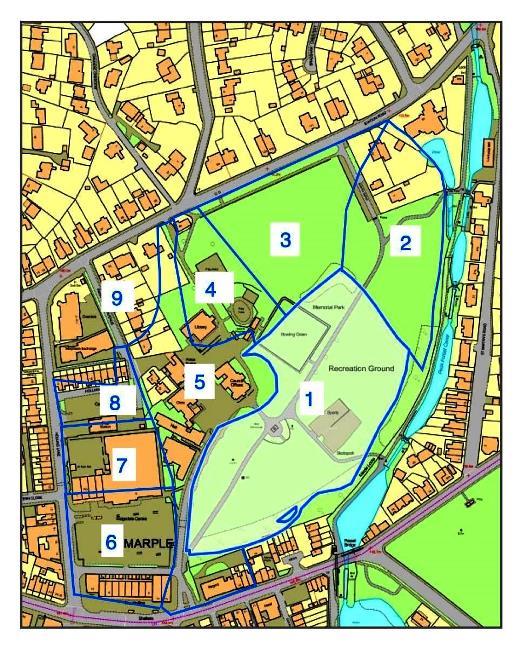 By 1919 Hollins Mill had been an integral part of the Marple community for over 80 years. When Charles Walmsley first built the mill in the 1830s he purchased much of the surrounding land as well. The tithe map of 1850 shows the use of the land at the time the mill was purchased by the Carver and Hodgkinson families. Almost all the land was owned by the mill with the exception of Cart Leach, (Plot 2), a meadow owned by Peter Arkwright and Clayton Croft, (Plot 9), a meadow owned by the Bradshaw-Isherwoods. Almost all of the area that was to become the Memorial Park was meadow. Oswald Carver, Thomas’s eldest son, remembered it at the dedication ceremony in 1922. “Some of the happiest days of my childhood were in connection with the land on which we stand, then a hayfield. The joy of playing amongst the hay and climbing to the top of a fully laden wagon is a memory that will last with me for ever.”
By 1919 Hollins Mill had been an integral part of the Marple community for over 80 years. When Charles Walmsley first built the mill in the 1830s he purchased much of the surrounding land as well. The tithe map of 1850 shows the use of the land at the time the mill was purchased by the Carver and Hodgkinson families. Almost all the land was owned by the mill with the exception of Cart Leach, (Plot 2), a meadow owned by Peter Arkwright and Clayton Croft, (Plot 9), a meadow owned by the Bradshaw-Isherwoods. Almost all of the area that was to become the Memorial Park was meadow. Oswald Carver, Thomas’s eldest son, remembered it at the dedication ceremony in 1922. “Some of the happiest days of my childhood were in connection with the land on which we stand, then a hayfield. The joy of playing amongst the hay and climbing to the top of a fully laden wagon is a memory that will last with me for ever.”
- 1. Little Cart Leach - Meadow 5.25 acres
- 2. Cart Leach - Meadow 3acres (Peter Arkwright)
- 3. Great Cart Leach - Meadow 3 acres
- 4. Lesser Well Field - 1.25 acres
- 5. Hollins House, Yard, Garden, road plantation - 3 acres
- 6. Cotton Mill Yard - 1.75 acres
- 7. Part of a Meadow - 1.25 acres
- 8. Hollins Farm Buildings - 0.5 acres
- 9. Clayton Croft - Meadow - 1.75 acres (Bradshaw & Isherwood)
The whole area around the mill commanded a clear view over the Goyt valley towards Cobden Edge and the Derbyshire Peak. The Carver family appreciated this and plots 1, 3 and 4 were kept clear and open for their enjoyment. When the opportunity arose they also purchased Cart Leach meadow (Plot 2) from the Arkwright family. For much of the second half of the nineteenth century it was the centre of a family home enjoyed by Thomas and Hannah Carver with their seven children. However, times change and the children gradually moved away. The new generation did not feel it was necessary to live next door to the mill. They did not move far but they did move away from Hollins Mill to large houses in the district - Woodville, Stonehurst, Yateley, Beamsmoor. Rose Hill, Beechwood, The Hollies and Poise House in Hazel Grove were all occupied at one time or another by members of the family but Hollins House remained the centre as long as Thomas and Hannah lived there. Thomas retired from the mill in 1898 and in 1904 he and Hannah moved to Southport. At the time Thomas placed a large advertisement in the Stockport Advertiser stating that he was letting Hollins House although continuing his links with Marple. Nevertheless, the family link between the house and the town was broken.
 The offer of land as a memorial to the fallen was a generous gesture by the Carver family but perhaps made easier by the fact that the family was becoming more detached from the mill and from the town. The initial offer was for a gift of eight acres to be called “The Carver-Barlow Park.” However, a lot of fine detail was discussed over the next three years. The War Memorial Committee was involved in these discussions but it was a voluntary body with no official presence and the members of which changed considerably over time. The real negotiations were between Hollins Estate and Marple UDC, the former owning the land and the latter having to take responsibility for it after transfer. The first sticking point was the proposed name - considerable objections were raised about using an individual name. However, the Carver family recognised this obstacle and agreed that it could be called “The War Memorial Park.”
The offer of land as a memorial to the fallen was a generous gesture by the Carver family but perhaps made easier by the fact that the family was becoming more detached from the mill and from the town. The initial offer was for a gift of eight acres to be called “The Carver-Barlow Park.” However, a lot of fine detail was discussed over the next three years. The War Memorial Committee was involved in these discussions but it was a voluntary body with no official presence and the members of which changed considerably over time. The real negotiations were between Hollins Estate and Marple UDC, the former owning the land and the latter having to take responsibility for it after transfer. The first sticking point was the proposed name - considerable objections were raised about using an individual name. However, the Carver family recognised this obstacle and agreed that it could be called “The War Memorial Park.”
The UDC , although welcoming the idea as a benefit for the community, had considerable reservations about costs - the cost of establishing various amenities and the ongoing maintenance costs. They also wanted to exclude team games such as football and cricket on the grounds that these were not decorous games suitable for a war memorial. Much of the discussion in the minutes of the memorial committee was about money - how to collect it and how to spend it. The first priority was for the war memorial itself and a granite sculpture. Initially the idea was for a simple cross on a plinth but it was agreed that, for an extra £35 additional to the original £350, an allegorical sculpted statue would be more appropriate. The sculpted statue shows a draped female figure with hands clasped but there is no note as to what allegory she represents. Certainly not Victory as she does not have wings but it could perhaps be Hope or Peace or even Remembrance. But does it matter? Such a figure is preferable to a cross as it is non-denominational and suitable for all. This statue is mounted on a square plinth which , in turn, is set on a square base. The inscription and the names of the fallen are listed on three sides of both the plinth and the base.
Eventually most of the problems for the park, major and minor, were settled. The original eight acres promised was now 13 acres, thanks to an additional gift by Ernest Bagshawe (né Carver) whose son had been killed at Ypres. In addition the family presented a pair of gates for the entry to the park on Stockport Road. Hollins House, the centrepiece of the planned park, was sold by the Hollins Estate to Marple UDC with the intention of it replacing the old offices on Market Street. After all the negotiations had been settled there was a massive celebration on 22nd July, 1922 to dedicate the war memorial and to mark the acquisition by the town of this important new asset for the community. It is estimated that 10,000 people attended, an impressive number considering the population of the township at the time was only about 6500. The dedication itself followed a procession through the town but afterwards there was a dramatic pageant marking one thousand years of the history of the town.
 So what had the community gained? A map surveyed in 1917 shows the extent and use of the land before the transfer, whilst the Carvers were in ownership. Hollins House was the centre with two entrance drives, one from Stockport Road, the other from Station Road, both guarded by an entrance lodge. Between the main house and the three terraces of millworkers houses there was an open space called Hollins Fold, probably occupied by gardens and orchard. However, on three sides of the house, stretching eastwards towards the Goyt valley was a large extent of twelve acres of open ground. This was the embryonic Memorial Park.
So what had the community gained? A map surveyed in 1917 shows the extent and use of the land before the transfer, whilst the Carvers were in ownership. Hollins House was the centre with two entrance drives, one from Stockport Road, the other from Station Road, both guarded by an entrance lodge. Between the main house and the three terraces of millworkers houses there was an open space called Hollins Fold, probably occupied by gardens and orchard. However, on three sides of the house, stretching eastwards towards the Goyt valley was a large extent of twelve acres of open ground. This was the embryonic Memorial Park.
Memorial Park area 1917
[note the canal branch that ran into Hollins Mill, towards the bottom of the map image]
Once the park came under the auspices of the UDC changes began to be made but only gradually - money was always a restraint. The first was the erection of a memorial to those killed in the war. The monument was given pride of place directly in front of Hollins House. Gradually various amenities were added for the people using the park and by 1934 it had been transformed from a private estate to a public park.
Memorial Park area 1934
Hollins House was still the centre with two driveways leading up to it but the entrance lodge on Stockport Road went in the 1950s, replaced by the gates. The extensive collection of garden gnomes that guarded the entrance lodge also disappeared; a sad loss to the community. Near the main house a large bowling green had been created, twice as large as its nearest competitor at the Liberal Club. A shelter and a small pavilion were close to the bowling green. The pavilion had come at no cost to the community as it had been built by returning soldiers, in memory of their fallen comrades. A putting green was laid out adjacent to the bowling green. For the more athletically inclined there were two tennis courts, one grass, one shale, again with a small pavilion. However there seem to be no new buildings in the Hollins Fold area. A separate building behind Hollins House which had been stables and workshops when the Carvers lived there was turned into community use. The ground floor became the fire station, housing the single appliance (usually a Dennis) and a tender or Landrover for other types of emergency. It was manned entirely by a volunteer force. Also on the ground floor was a small room used for a mortuary. It had a small window mounted high up and, with some effort, the local youths could peer in to view the slab. Fortunately it was rarely occupied. The whole of the first floor was used as a meeting room for the scouts.
The war came and developments in the park went into reverse. No more expenditure for sports amenities but instead areas were allocated for allotments and for training purposes. Even the war memorial was taken down and stored in a safe place until the end of the war. Sadly, by the time the war ended and the memorial could be reassembled, there were another fifty names to be inscribed. There was no room on the original monument and their sacrifice needed to be recognised as separate from that of their fathers in the Great War. As a result it was decided that the names should be inscribed on two granite slabs, alongside, but still part of, the original monument but distinct from it.
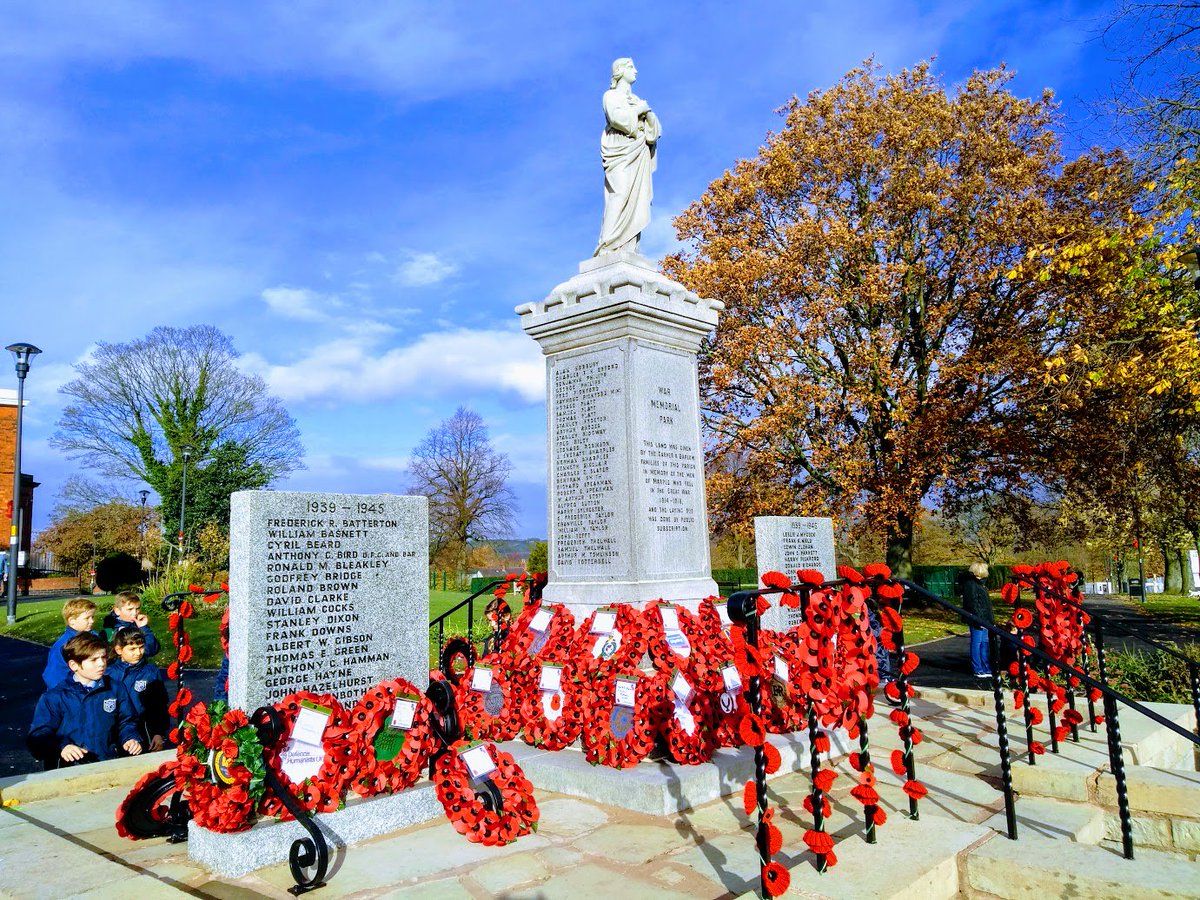
However, as an aside, it was almost certainly on this occasion when the monument was reassembled incorrectly. The original design listed all the names in alphabetical order, starting on the top of the east face of the plinth, carrying on down the square base and then back to the north face of the plinth etc. In diagrammatic form the names were listed thus:
East South West North
Upper plinth A-C F-J N-T Inscription
Lower base C-F J-N T-Y -
Unfortunately either the plinth or the square base got rotated 180 degrees so the names now read:
East South West North
Upper plinth A-C Inscription N-T F-J
Lower base T-Y J-N C-F -
We don’t know if this was spotted at the time or whether it went unnoticed for years but does it matter? No it doesn’t. The important thing is that the sacrifice these men made should be recognised and remembered. And so it has been each Remembrance Day ever since when this cenotaph is the centrepiece of the ceremony with representatives of the whole community. Indeed, if this error draws more attention to the names thereon, so much the better.
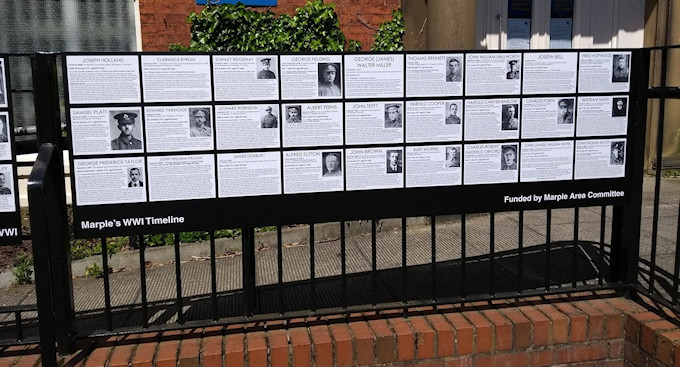 “Marple's WWI Timeline” in the Memorial Park.
“Marple's WWI Timeline” in the Memorial Park.
Commemorating the Centenary of the First World War and to highlight the impact it had on a small town like Marple
Probably one of the most moving ceremonies in the park lasted far longer than a single day in November. Between 2014 and 2018 short biographies, and in most cases a photograph, of every man killed were mounted on the railings outside Hollins House facing the war memorial. The biography was mounted on the exact centenary of each man’s death. Just a few at first but, as the months went by, more and more anniversaries were marked and the total grew remorselessly. This was particularly moving as not only did it give life to the names on the memorial but the cumulative growth in numbers over the period gave the modern community a real feeling for the atmosphere at the time. Since 1945 there has only been one new name added to the memorial, marking a soldier killed in conflict but even that is one too many. However, the Park has continued to develop and change to meet the needs and desires of the community.
Changes were slow at first but it was gradually brought back to its pre-war normalcy. The first really big event after the war was a celebration of the Queen’s coronation in 1953 including tree planting. Then, as the wartime austerity faded, Marple UDC used the central location to build services for the community. By 1969, in the days before political correctness, an Old Folks Hall had been built on the driveway to the council offices with a small library next to it. This latter replaced the library that had been in Church Lane. In Hollins Fold a community clinic was established and a small police station. Slightly outside the environs of the park one of the rows of mill cottages had been demolished and a fire station put in its place.
Inside the park the tennis courts had been reduced to one but the pavilion still remained. The putting green too had disappeared to make way for a boating pool. A playground with swings and a slide was where the library now stands but they were soon to be displaced. Another use had been found for the park, as a repository for local heritage artefacts which needed a new home. The village stocks which had been outside the Ring o’ Bells public house were moved to the park and so too was the sundial which had graced the front garden of Marple Hall before it was demolished. Other items of historical interest followed over the years.
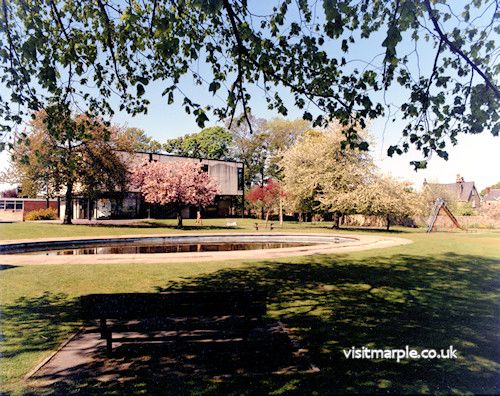
Boating Pool and Library in Memorial Park
The boating pool in Marple Memorial Park, mid to late 1970s (the library was built in 1974). Provided by Caroline Calverley.
1972 saw the fiftieth anniversary of the opening of the park and a year later, In 1973, the new library was opened to great fanfare. This must have been the swan song of Marple UDC because the next year it was absorbed into the newly created Stockport MBC. It was certainly an asset to the community with its ground floor library, first floor study facilities and flexible meeting rooms. The previous library, next to what was now called the Senior Citizens Hall, was given over for the use of the scouts and doubled in size to accommodate their requirements. Later in the 1970s the second of the mill terraces was demolished to be replaced by a car park, leaving only Hollins Terrace which comprised slightly larger houses than the other two terraces. Ten years later the weaving sheds, the last of the mill buildings, were demolished and a large superstore with associated car park built. Optimistically called the Ridgeway Centre by the developers, it was known as the Co-op by everyone else.
Inside the park, the play area was moved from the library site to the other side of the path. Various equipment was added but there was then a major re-arrangement. The boating pool was filled in and a special area for toddlers with appropriate equipment was 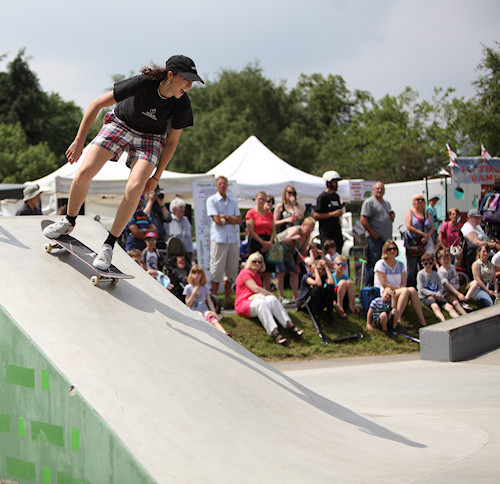
The multi-use purpose of the park has been expanded with a new feature. An area of about an acre has been set aside to allow nature to flourish more readily, encouraging insects and wildlife. These are the obvious changes but a more subtle change has seen the community take more responsibility for the park. This is exemplified by the Friends of Marple Memorial Park, a voluntary organisation that has been taking on roles since 2002 that were previously carried out by the council.
Is this the way of the future or will the wheel turn again? We don’t know but what we do know is that the Memorial Park has changed a lot in the last century and it will continue to change over the next century. When Oswald Carver handed over the deeds to the park at the dedication ceremony on 22nd July 1922 he expressed the hope that “ the Park will prove a valuable and useful part of the life and recreation of the people of this town.” It certainly has and will continue to be.
Neil Mullineux - July 2022
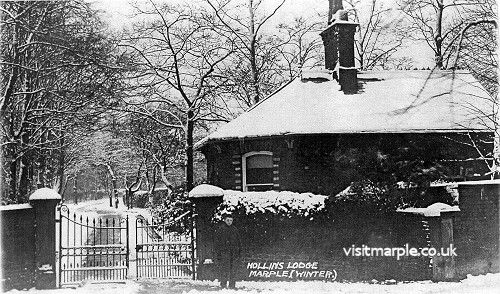 Memorial Park - Stockport Road Lodge
Memorial Park - Stockport Road Lodge
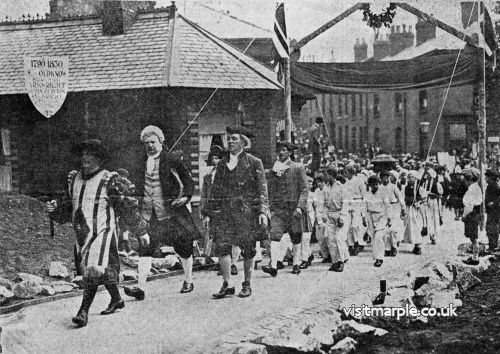
A newspaper cutting of the 1922 Historical Pageant entering Memorial Park from Stockport Road
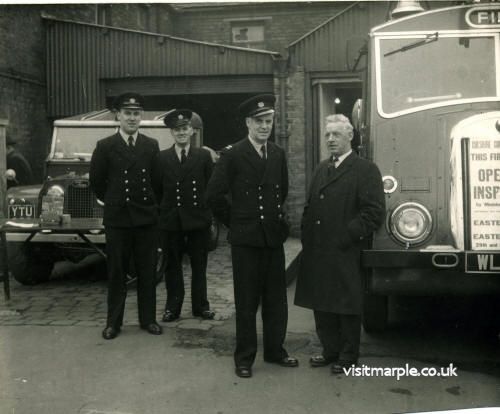 Fire Station Open Day at Easter, sometime in the 1950s
Fire Station Open Day at Easter, sometime in the 1950s
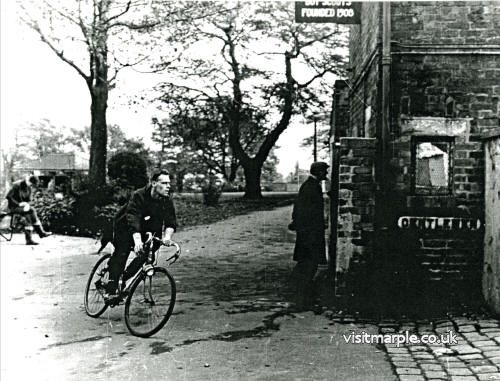 Part-time fire fighter Derek Peak arriving by bicycle at the old Fire Station in Memorial Park, 1966
Part-time fire fighter Derek Peak arriving by bicycle at the old Fire Station in Memorial Park, 1966
